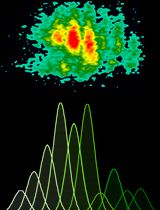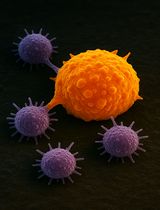- 提交稿件
- 订阅
- CN
- EN - English
- CN - 中文
- EN - English
- CN - 中文
Evaluation of Cross-presentation in Bone Marrow-derived Dendritic Cells in vitro and Splenic Dendritic Cells ex vivo Using Antigen-coated Beads
使用抗原包被珠子评价体外骨髓源性树突状细胞和离体脾树突状细胞的交叉呈递
发布: 2016年11月20日第6卷第22期 DOI: 10.21769/BioProtoc.2015 浏览次数: 11882
评审: Ivan ZanoniPer AndersonShanie Saghafian-Hedengren

相关实验方案

使用康可藻红素刺激冷冻保存的猪外周单个核细胞进行增殖检测,并结合FCS ExpressTM 7.18软件分析
Marlene Bravo-Parra [...] Luis G. Giménez-Lirola
2025年06月05日 1600 阅读
Abstract
Antigen presentation by MHC class I molecules, also referred to as cross-presentation, elicits cytotoxic immune responses. In particular, dendritic cells (DC) are the most proficient cross-presenting cells, since they have developed unique means to control phagocytic and degradative pathways.
This protocol allows the evaluation of antigen cross-presentation both in vitro (by using bone marrow-derived DC) and ex vivo (by purifying CD8+ DC from spleen after incorporation of particulate antigen) using ovalbumin (OVA)-coupled particles. Cross-presentation efficiency is measured by three different readouts: the B3Z hybridoma T cell line (Karttunen et al., 1992) and stimulation of antigen-specific CD8+ T cells (OT-I) (Kurts et al., 1996), either analyzing OT-I activation by CD69 expression or OT-I proliferation after labeling them with carboxyfluorescein succinimidyl ester (CFSE). By using this approach, we could show recently that DCs are able to increase cross-presentation efficiency transiently upon engagement of TLR4 (Alloatti et al., 2015).
Background
In mouse, antigen-presenting cells (APC) are able to take up exogenous antigens to process them and to load peptides derived from such exogenous antigens onto major histocompatibility complex (MHC) class I molecules. Peptide-MHC I complexes are subsequently transported to the plasma membrane, where they might be presented to CD8+ T cells thereby promoting T cell activation, a process referred to as cross-presentation (Joffre et al., 2012). Among the different APC, dendritic cells (DC) excel at cross-presentation and comprise of different subpopulations expressing the XCR1 marker, which have been shown to cross-present antigens very efficiently (i.e., CD8+ resident DC from spleen and CD103+ migratory DC from skin and lung) (Dorner et al., 2009; Crozat et al., 2011). While the purification of DC residing in spleen or migratory DC is feasible, it is laborious and expensive. In order to study the cell biology of DC, primary cultures of bone marrow-derived DC (BMDC) can be easily differentiated from myeloid progenitors by culturing them with GM-CSF. Even though BMDC cannot be associated with any particular DC subtype (perhaps inflammatory DC), they constitute a valuable tool to study the main characteristics of DC cell biology. Herein, we introduce a detailed protocol to analyze cross-presentation of particulate antigen by BMDC, but also by CD8+ splenic DC. Although previous protocols included different antigen forms and read-outs, the protocol described here aims to analyze cross-presentation in a comprehensive and concise way in different DC types.
Materials and Reagents
- 2 ml Eppendorf tubes
- 15 ml centrifuge tubes
- 50 ml centrifuge tubes
- 14 ml tubes
- FisherbrandTM cell strainer (Thermo Fisher Scientific, Fisher Scientific, catalog number: 22-363-548 )
- Pre-separation filters (30 μm) (Miltenyi Biotec, catalog number: 130-041-407 )
- 1 ml insulin syringes (Terumo Medical, catalog number: SS+01H1 )
- 2.5 ml syringes
- 25 G needles (Terumo, catalog number: AN*2516R1 )
- Non-treated 96-well plates (Coring, Falcon®, round bottom, catalog number: 351177 )
- Non-treated 6-well plates (Sigma-Aldrich, catalog number: M8562-100EA )
- Non-treated Petri dish, 145 x 20 mm (Greiner Bio One, catalog number: 639161 )
- Mice: C57BL/6 and C57BL/6 recombination activating gene 1-deficient OT-I TCR (Vα2, Vβ5) transgenic mice were obtained from Charles River Laboratories (CDTA, Orleans, France)
- B3Z T cell line (a Kb-restricted, OVA-specific CD8+ T cell hybridoma) (Kurts et al., 1996)
- Low endotoxin OVA (50 mg/ml stock) (Worthington Biochemical, catalog number: LS003062 )
- OVA peptide 257-264 (SIINFEKL) (Polypeptide, catalog number: SC1302 )
- Polybead® polystyrene 3.0 micron microspheres (Polysciences, catalog number: 17134 )
- Polybead® dyed blue 1.0 micron microspheres (Polysciences, catalog number: 15712 )
- PBS (1x, pH 7.4) (Thermo Fisher Scientific, GibcoTM, catalog number: 10010-023 )
- Glycine (Sigma-Aldrich, catalog number: 50046 )
- Glutaraldehyde (25%) (Sigma-Aldrich, catalog number: G5882 )
- Iscove’s modified Dulbecco’s medium (IMDM) (Sigma-Aldrich, catalog number: I3390-500ML )
- Penicillin-streptomycin (10,000 U/ml) (Thermo Fisher Scientific, GibcoTM, catalog number: 15140122 )
- RPMI with GlutaMAXTM (Thermo Fisher Scientific, catalog number: 61870-010 )
- GlutaMAXTM supplement (100x) (Thermo Fisher Scientific, GibcoTM, catalog number: 35050061 )
- β-mercaptoethanol (Thermo Fisher Scientific, GibcoTM, catalog number: 21985-023 )
- MEM non-essential amino acids solution (100x) (Thermo Fisher Scientific, GibcoTM, catalog number: 11140050 )
- Sodium pyruvate (100 mM) (Thermo Fisher Scientific, GibcoTM, catalog number: 11360070 )
- CPRG (Roche Diagnostics, catalog number: 10884308001 )
- Fixable viability dye eFluor 780 (dilution 1/10,000) (Affymetrix, eBioscience, catalog number: 65-0865-14 )
- Low endotoxin fetal bovine serum (FBS, heat-inactivated for 20 min at 56 °C) (Biowest, catalog number: S1860 )
- Low endotoxin BSA (fraction V) (Euromedex, catalog number: UA1315 )
- CFSE (Thermo Fisher Scientific, Molecular ProbesTM, catalog number: C34554 )
- Liberase TM (Roche Diagnostics, catalog number: 05401119001 )
- DNase I (Roche Diagnostic, catalog number: 04536282001 )
- Red blood cell lysis buffer (Sigma-Aldrich, catalog number: R7757 )
- EasySepTM Mouse Pan-DC Enrichment Kit (STEMCELL Technologies, catalog number: 19763 )
- EasySepTM Mouse Naïve CD8+ T Cell Isolation Kit (STEMCELL Technologies, catalog number: 19858 )
- FACS antibodies (all anti-mouse):
- CD69-eFluor® 450 (clone H1.2F3, dilution 1/300) (Affymetrix, eBioscience, catalog number: 48-0691-82 )
- CD8a-PerCP-Cy5.5 (clone 53-6.7, dilution 1/300) (Affymetrix, eBioscience, catalog number: 45-0081-82 )
- TCR vβ 5.1-PE (clone MR9-4, dilution 1/500) (BD, PharmingenTM, catalog number: 553190 )
- CD25-FITC (clone 7D4, dilution 1/200) (BD, PharmingenTM, catalog number: 553072 )
- CD4-PE-Cy7 (clone RM4-5, dilution 1/300) (BD, PharmingenTM, catalog number: 552775 )
- CD25-APC (clone PC61.5, dilution 1/300) (Affymetrix, eBioscience, catalog number: 17-0251-81 )
- CD19 eFluor® 450 (clone 1D3, dilution 1/500) (Affymetrix, eBioscience, catalog number: 48-0193 )
- CD3 eFluor® 450 (clone 17A2, dilution 1/500) (Affymetrix, eBioscience, catalog number: 48-0032-80 )
- CD11c-FITC (clone HL3, dilution 1/500) (BD, PharmingenTM, catalog number: 553801 )
- CD11c-APC (clone N418, dilution 1/400) (Affymetrix, eBioscience, catalog number: 17-0114 )
- CD8-PE (clone 53-6.7, dilution 1/500) (BD, PharmingenTM, catalog number: 553032 )
- CD11b-PE (clone M1/70, dilution 1/300) (Affymetrix, eBioscience, catalog number: 12-0112 )
- CD40-PE (clone 3/23, dilution 1/150) (BD, PharmingenTM, catalog number: 553791 )
- CD86-PE (clone GL1, dilution 1/300) (Affymetrix, eBioscience, catalog number: 12-0862 )
- MHC Class II I-Ab-PE (clone AF6-120.1, dilution 1/300) (Affymetrix, eBioscience, catalog number: 12-5320 )
- CD69-eFluor® 450 (clone H1.2F3, dilution 1/300) (Affymetrix, eBioscience, catalog number: 48-0691-82 )
- BMDC culture medium (see Recipes)
- B3Z and T cell culture (see Recipes)
- Digestion medium for spleens (see Recipes)
- MACS buffer (see Recipes)
Equipment
- Incubator (37 °C and 5% CO2)
- Refrigerated centrifuge for tubes of 2 ml, 15 ml and 50 ml size as well as 96-well plates
- Stuart test tube rotator wheel tolerating 4 °C (Bibby Scientific, model: SB3 )
- Multicolor flow cytometer (MAQSquant, Miltenyi; FACSverse, Becton Dickinson or similar)
- Multicolor FACS sorter (for example, BD, model: FACSAria III )
- Fluorometric plate reader (OD: 590 nm)
Software
- FlowJo 10 software (FlowJo, LLC.)
- Prism 6 software (GraphPad Software, Inc.)
Procedure
文章信息
版权信息
© 2016 The Authors; exclusive licensee Bio-protocol LLC.
如何引用
Alloatti, A., Kotsias, F., Hoffmann, E. and Amigorena, S. (2016). Evaluation of Cross-presentation in Bone Marrow-derived Dendritic Cells in vitro and Splenic Dendritic Cells ex vivo Using Antigen-coated Beads. Bio-protocol 6(22): e2015. DOI: 10.21769/BioProtoc.2015.
分类
免疫学 > 免疫细胞功能 > 树突细胞
细胞生物学 > 基于细胞的分析方法 > 流式细胞术
细胞生物学 > 基于细胞的分析方法
您对这篇实验方法有问题吗?
在此处发布您的问题,我们将邀请本文作者来回答。同时,我们会将您的问题发布到Bio-protocol Exchange,以便寻求社区成员的帮助。
提问指南
+ 问题描述
写下详细的问题描述,包括所有有助于他人回答您问题的信息(例如实验过程、条件和相关图像等)。
Share
Bluesky
X
Copy link












